| |
| Research Overview |
Decarbonization of the global energy system is becoming increasingly essential for efforts to combat the threat of regional deterioration of air quality and global climate change. Low-carbon electric power systems are particularly important given the growing role of electricity in the future energy system. My longer-term research interests will emphasize study of the technical, economic, social and environmental dimensions of low or zero carbon energy sources as a means to reduce emissions of carbon dioxide (CO2).
My PhD research work focused on an evaluation of the potential of wind power as a cost-effective means to reduce emissions of CO2 using an integrative approach with an interdisciplinary perspective. I developed a spatio-temporal model based on Geographical Information Systems (GIS) for a comprehensive understanding of the physical possibility, economic feasibility and cost of cutting carbon emissions that could be realized by incorporating wind power in a power system without compromising its reliability. My postdoc research invovles developing an econometric model based on merit-order theory and applying it to explore specifically how the fuel mix in the U.S. power system would respond over the short term to changing relative prices for coal and gas.
Currently, I am a research associate working with Prof. Michael B. McElroy in the School of Engineering and Applied Sciences at Harvard University. My current research interests include: (1) options to mitigate variations of wind power and solar power, and their complementary effects; (2)interactions between development of meteorology-driven renewables and climate change; and (3) challenges and opportunities for low-carbon electric power systems in both China and the U.S.
|
Opportunity for Offshore Wind to Reduce Future Demand for Coal-Fired Power Plants in China with Consequent Savings in Emissions of CO2 (pdf)
Although capacity credits for wind power have been embodied in power systems in the U.S. and Europe, the current planning framework for electricity in China ontinues to treat wind power as a non-dispatchable source with zero contribution to firm capacity. This study adopts a rigorous reliability model for the electric power system evaluating capacity credits that should be recognized for offshore wind resources supplying power demands for Jiangsu, China. Jiangsu is an economic hub located in the Yangtze River delta accounting for 10% of the total electricity consumed in China. Demand for electricity in Jiangsu is projected to increase from 331 TWh in 2009 to 800 TWh by 2030. Given a wind penetration level of 60% for the future additional Jiangsu power supply, wind resources distributed along the offshore region of five coastal provinces in China (Shandong, Jiangsu, Shanghai, Zhejiang and Fujian) should merit a capacity credit of 12.9%, the fraction of installed wind capacity that should be recognized to displace coal-fired systems without violating the reliability standard. In the high-coal-price scenario, with 60% wind penetration, reductions in CO2 emissions relative to a business as usual reference could be as large as 200.2 million tons of CO2 or 51.8% of the potential addition, with a cost for emissions avoided of $29.0 per ton.
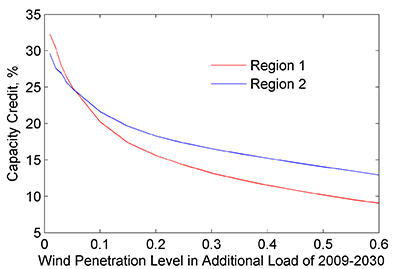
|
|
Optimal integration of offshore wind power for a steadier, environmentally friendlier, supply of electricity in China (pdf)
Demand for electricity in China is concentrated to a significant extent in its coastal provinces. Opportunities for production of electricity by on-shore wind facilities are greatest, however, in the north and west of the country. Using high resolution wind data derived from the GEOS-5 assimilation, this study shows that investments in off-shore wind facilities in these spatially separated regions (Bohai-Bay or BHB, Yangtze-River Delta or YRD, Pearl-River Delta or PRD) could make an important contribution to overall regional demand for electricity in coastal China. An optimization analysis indicates that hour-to-hour variability of outputs from a combined system can be minimized by investing 24% of the power capacity in BHB, 30% in YRD and 47% in PRD. The analysis suggests that about 28% of the overall off-shore wind potential could be deployed as base load power replacing coal-fired system with benefits not only in terms of reductions in CO2 emissions but also in terms of improvements in regional air quality. The interconnection of off-shore wind resources contemplated here could be facilitated by China's 12th-five-year plan to strengthen inter-connections between regional electric-power grids.
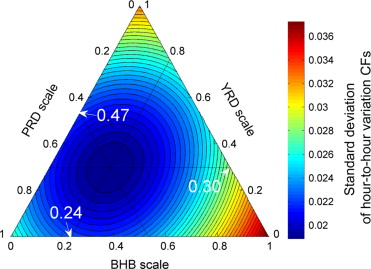

|
Accelerated Reduction in SO2 Emissions from the US Power Sector Triggered by Changing Prices of Natural Gas (pdf)
Emissions of sulfur dioxide (SO2) from the U.S. power sector decreased by 24% in 2009 relative to 2008. The Logarithmic Mean Divisia Index (LMDI) approach was applied to isolate the factors responsible for this decrease. It is concluded that 15% of the decrease can be attributed to the drop in demand for electricity triggered by the economic recession, and 28% can be attributed to switching of fuel from coal to gas responding to the decrease in prices for the latter. The largest factor in the decrease, close to 57%, resulted from an overall decline in emissions per unit of power generated from coal. This is attributed in part to selective idling of older, less efficient coal plants that generally do not incorporate technology for sulfur removal, and in part to continued investments by the power sector in removal equipment in response to the requirements limiting emissions imposed by the U.S. Environmental Protection Agency (U.S. EPA). The paper argues further that imposition of a modest tax on emissions of carbon would have ancillary benefits in terms of emissions of SO2.

|
Implications of the Recent Reductions in Natural Gas Prices for Emissions of CO2 from the US Power Sector (pdf)
CO2 emissions from the US power sector decreased by 8.76% in 2009 relative to 2008 contributing to a decrease over this period of 6.59% in overall US emissions of greenhouse gases. An econometric model, tuned to data reported for regional generation of US electricity, is used to diagnose factors responsible for the 2009 decrease. More than half of the reduction is attributed to a shift from generation of power using coal to gas driven by a recent decrease in gas prices in response to the increase in production from shale. An important result of the model is that, when the cost differential for generation using gas rather than coal falls below 2-3 cents/kWh, less efficient coal fired plants are displaced by more efficient natural gas combined cycle (NGCC) generation alternatives. Costs for generation using NGCC decreased by close to 4 cents/kWh in 2009 relative to 2008 ensuring that generation of electricity using gas was competitive with coal in 2009 in contrast to the situation in 2008 when gas prices were much higher. A modest price on carbon could contribute to additional switching from coal to gas with further savings in CO2 emissions.

|
Costs for Integrating Wind into the Future ERCOT System with Related Costs for Savings in CO2 Emissions (pdf)
Wind power can make an important contribution to the goal of reducing emissions of CO2. The major problem relates to the intrinsic variability of the source and the difficulty of reconciling the supply of electricity with demand particularly at high levels of wind penetration. This challenge is explored for the case of the ERCOT system in Texas. Demand for electricity in Texas is projected to increase by approximately 60% by 2030. Considering hourly load data reported for 2006 assuming that the pattern of demand in 2030 should be similar to 2006 and adopting as a business as usual (BAU) reference an assumption that the anticipated additional electricity should be supplied by a combination of coal and gas with prices, discounted to 2007 dollars of $2 and $6 per MMBTU respectively, we conclude that the bus-bar price for electricity would increase by about 1.1 c/kWh at a wind penetration level of 30%, by about 3.4 c/kWh at a penetration level of 80%. Corresponding costs for reductions in CO2 range from $20/ton to $60/ton. A number of possibilities are discussed that could contribute to a reduction in these costs including the impact of an expanded future fleet of electrically driven vehicles.
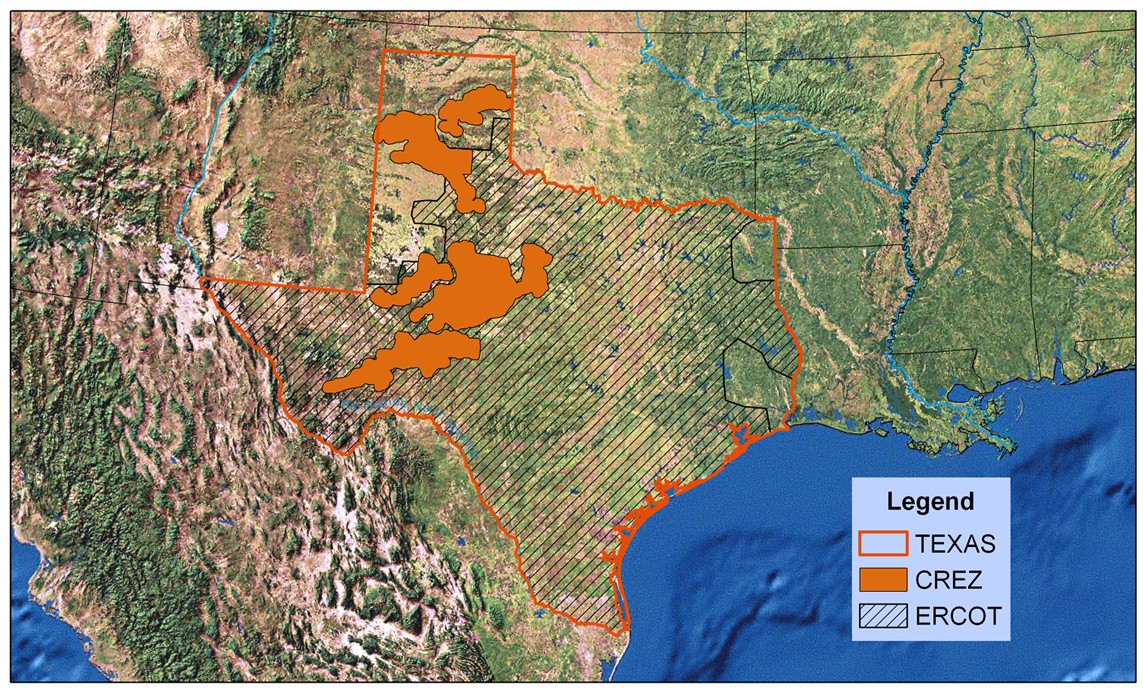
|
The Impact of Production Tax Credits on the Profitable Production of Electricity from Wind in the U.S. (pdf)
A spatial financial model using wind data derived from assimilated meteorological condition was developed to investigate the profitability and competitiveness of onshore wind power in the contiguous U.S. It considers not only the resulting estimated capacity factors for hypothetical wind farms but also the geographically differentiated costs of local grid connection. The levelized cost of wind-generated electricity for the contiguous U.S. is evaluated assuming subsidy levels from the Production Tax Credit (PTC) varying from 0 to 4 c/kWh under three cost scenarios: a reference case, a high cost case, and a low cost case. The analysis indicates that in the reference scenario, current PTC subsidies of 2.1 c/kWh are at a critical level in determining the competitiveness of wind-generated electricity compared to conventional power generation in local power market. Results from this study suggest that the potential for profitable wind power with the current PTC subsidy amounts to more than seven times existing demand for electricity in the entire U.S. Understanding the challenges involved in scaling up wind energy requires further study of the external costs associated with improvement of the backbone transmission network and integration into the power grid of the variable electricity generated from wind.

|
| |
Electricity that could be competitively generated by wind in the contiguous U.S. as a function of PTC levels: blue solid line for the scenario of reference case; red dashed line for the high cost scenario; green dashed line for the low cost scenario. The current PTC subsidy is indicated by the vertical dashed black line. |
|
Potential for Wind Generated Electricity in China (pdf)
Wind offers an important alternative to coal as a source of energy for generation of electricity
in China with the potential for substantial savings in carbon dioxide emissions. Wind fields derived
from assimilated meteorological data are used to assess the potential for wind-generated electricity
in China subject to the existing government-approved bidding process for new wind farms.
Assuming a guaranteed price of 0.516 RMB (7.6 U.S. cents) per kilowatt-hour for delivery of
electricity to the grid over an agreed initial average period of 10 years, it is concluded that wind
could accommodate all of the demand for electricity projected for 2030, about twice current
consumption. Electricity available at a concession price as low as 0.4 RMB per kilowatt-hour would
be sufficient to displace 23% of electricity generated from coal.
(Science link) (Science front cover)
|
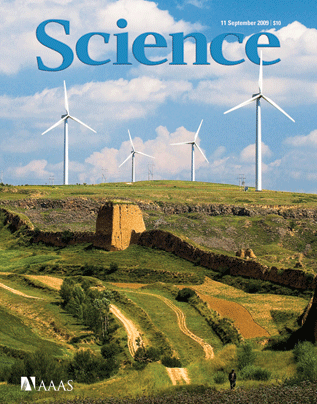 . . |
|
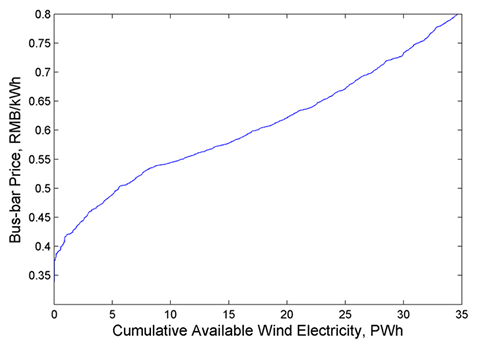 |
|
| |
Potential electricity
that could be generated nationally as a function of busbar concession price |
|
| |
COVER Wind turbines near the Great Wall in Shanxi, China |
|
. |
|
Potential for Wind Generated Electrciity (pdf)
The potential of wind power as a global source of electricity is assessed using winds derived through assimilation of data from a variety of meteorological sources. The analysis indicates that a network of land-based 2.5 MW turbines restricted to non-forested, ice-free, non-urban areas operating at as little as 20% of their rated capacity, could supply more than 40 times current worldwide consumption of electricity, more than 5 times total global use of energy in all forms. Resources in the contiguous US, specifically in the central plain states, could accommodate as much as 16 times total current demand for electricity in the US. Estimates are given also for quantities of electricity that could be obtained using a network of 3.6 MW turbines deployed in ocean waters with depths less than 200 m within 50 nautical miles (92.6 km) of closest coastlines.

Distribution of global wind power capacity (blue, low; red, high)
|
|

 .
.








